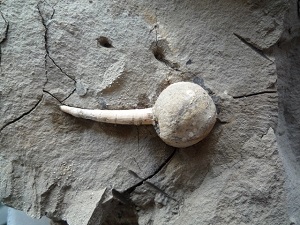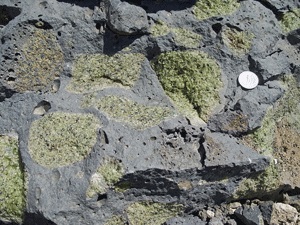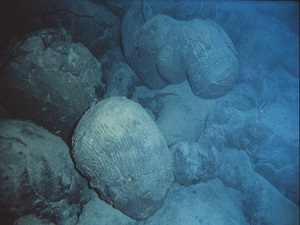Nagoya City Science Museum
TOP > Exhibition Guide > Floor Map> Clues to Earth in the Past
Clues to Earth in the Past



Purpose of Exhibition
How can we know about phenomena that have occurred in the Earth's past? The clues are rocks and minerals.
Additional Knowledge
[A clue to the origin of the Earth: Meteorites]
Primitive rocks that were formed when the Earth was born are not left on the Earth. But, they remain in the universe. Although it is difficult to go to pick it up, we can get them as meteorites. Approximately 86% of the meteorites are "chondrites" including round grains called "condorules". It is confirmed that the asteroid "Itokawa" consisits of chondrite by the exploration of "Hayabusa". *Check the meteorite specimens at the sixth floor as well.
[A clue to the mechanism of fossilization: Concretion]
A spherical solid mass called "concretion" occurs in sedimentary rocks. Carbonate concretions around the mouth of tusk-shells (Fissidentalium sp.), which are exhibited here, are found in Toyama Prefecture, Japan. Carbonate precipitated within several weeks to several months after the death of tusk-shells. It suggests surprisingly rapid formation of fossils.
[A clue to the nature of the mantle: Peridotite nodule] The olive-green crystals are beautiful gemstones called "peridot". The peridot mass in this basaltic rock is a "peridotite nodule". It was carried from the upper mantle to the surface by magma. It is a clue to know the untouchable deep mantle.
[A clue to activity of a submarine volcano: Pillow lava]
The surface of the lava flowing into the sea is rapidly cooled with water to form a hard shell. However, the inside remains molten. When pushed by the lava flowing from behind, it breaks the shell and flows out. It is cooled by sea water to make a new shell. This process forms piled pillow-shaped lava. Pillow lava is the evidence that it formed in the sea.
[A clue to fault activity: Fault rocks] Fault movement deforms rocks. Such rocks are called "fault rocks". Under high temperature and pressure conditions, a rock milled and recrystallizes into a fine-grained rock (mylonite), or a rock melts by frictional heat into a glassy rock (pseudotachylyte).
[A clue to underground environment: Minerals]
Mineral species depend on environmental conditions such as temperature, pressure and element distribution. For example, diamonds can only be formed deeper than 100 km underground. Rock salt can only be formed in an environment where water easily evaporates. Even in the same mineral, the difference in the amount of trace components or the shape of the crystals reflect the formation conditions. Therefore, analysis of minerals is a clue to know the underground environment.
Hidekazu Yoshida, Atsushi Ujihara, Masayo Minami, Yoshihiro Asahara, Nagayoshi Katsuta, Koshi Yamamoto, Sin-iti Sirono, Ippei Maruyama, Shoji Nishimoto, Richard Metcalfe (2015). Early post-mortem formation of carbonate concretions around tusk-shells over week-month timescales. Scientific Reports 5: 14123 doi: 10.1038/srep14123.pp 519-530. Galer, S. J. G., O'nions, R. K. (1989) Chemical and Isotopic Studies of Ultramafic Inclusions from the San Carlos Volcanic Field, Arizona: A Bearing on their Petrogenesis. Journal of Petrology 30, 1033-1064.
